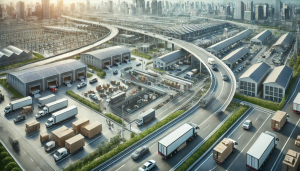Blog
How To Use Effective Transport Management In Logistics For Cost Efficiency
In today’s globalized economy, logistics and transportation play a crucial role in the success of businesses. However, managing these logistics costs efficiently is a constant challenge faced by many companies. Rising fuel prices, increased labor costs, and heightened customer expectations have made it more critical than ever for businesses to find innovative ways to maintain profitability while delivering high-quality service. This is where an effective Last Mile Transport Management System (TMS), particularly designed for last-mile delivery, becomes indispensable. By leveraging advanced technologies and optimized processes, a Last Mile TMS helps businesses achieve significant cost savings while ensuring operational excellence. This blog delves into the key benefits of using Last Mile TMS to drive cost efficiency in logistics and why it is a game-changer for modern supply chains.
Benefits of Using an Effective LAST Mile TMS for Cost Efficiency
Implementing a Transport Management System (TMS) designed for last-mile delivery can transform how businesses handle logistics, bringing multiple benefits that lead directly to cost efficiency. The right Last Mile TMS offers more than just a way to track deliveries; it becomes a strategic tool that enhances every aspect of the delivery process. From optimizing routes and reducing fuel consumption to automating administrative tasks and improving customer satisfaction, an effectiveLast Mile TMS addresses both visible and hidden costs across the supply chain. By providing real-time insights, fostering better resource utilization, and enabling data-driven decision-making, Last Mile TMS can help companies achieve substantial cost savings while maintaining high standards of service. Below, we explore the key benefits that make a Last Mile TMS an essential component for any business seeking to streamline logistics operations and improve their bottom line.
⦁ Reduced Fuel and Operational Costs:
A Last Mile TMS offers one of the most immediate and tangible benefits by lowering fuel and operational costs. Through sophisticated algorithms and machine learning, the system can determine the most efficient delivery routes, reducing unnecessary mileage, avoiding traffic-prone areas, and minimizing fuel consumption. Fewer miles traveled also means less wear and tear on vehicles, leading to lower maintenance and repair costs. Furthermore, Last Mile TMS allows businesses to better manage driver schedules, reducing overtime and ensuring optimal use of human resources. By streamlining these operations, Last Mile TMS can help businesses save a significant amount on fuel and operational expenses, directly impacting the bottom line.
⦁ Enhanced Delivery Efficiency:
Delivery efficiency is at the heart of any successful logistics operation. An effective Last Mile TMS automates crucial tasks such as scheduling, dispatching, and route planning, which eliminates human errors and reduces the time spent on manual processes. By utilizing real-time data, the system dynamically adjusts routes to avoid delays caused by traffic jams, road closures, or accidents. This agility ensures that deliveries are made on time, which not only enhances customer satisfaction but also minimizes costs associated with delays, such as penalties or expedited shipping fees. Additionally, faster deliveries mean that vehicles can complete more trips within the same timeframe, boosting overall productivity without additional costs.
Know more: How To Achieve Higher ROI in the Last Mile Delivery
⦁ Improved Resource Utilization:
Last Mile TMS provides logistics managers with comprehensive visibility over the entire fleet, including vehicle availability, capacity, and utilization rates. This enables better decision-making regarding resource allocation, ensuring that each vehicle is used to its fullest potential. By avoiding underutilization and reducing idle time, businesses can maximize the return on their assets, effectively lowering the cost per delivery. Moreover, by optimizing driver assignments and managing workloads more efficiently, companies can minimize labor costs and enhance workforce productivity, all of which contribute to a more cost-efficient operation.
⦁ Minimized Administrative Costs:
The traditional logistics process often involves a significant amount of paperwork, from order processing to invoicing and compliance documentation. A Last Mile TMS digitizes these tasks, automating everything from proof of delivery to real-time inventory updates and customer notifications. This shift to a paperless environment not only speeds up administrative processes but also reduces the costs associated with manual data entry, errors, and the storage of physical documents. Faster processing times lead to quicker billing cycles, improving cash flow and reducing the time it takes to reconcile payments. By minimizing administrative burdens, businesses can allocate their resources to more value-added activities, further enhancing cost efficiency.
⦁ Increased Customer Satisfaction and Retention:
Customer satisfaction is a key driver of business success, and Last Mile TMS significantly enhances the customer experience by providing real-time visibility and accurate delivery updates. Customers can track their orders in real-time, receive notifications about estimated arrival times, and even reschedule deliveries if needed. This level of transparency and control fosters trust and loyalty, increasing the likelihood of repeat business. Satisfied customers are also more likely to leave positive reviews and recommend the company to others, reducing the costs associated with acquiring new customers. Retaining existing customers is often far less costly than attracting new ones, so the benefits of improved customer satisfaction can be substantial.
⦁ Better Compliance and Risk Management:
Compliance with industry regulations and standards is essential for avoiding costly fines, penalties, and legal issues. Last Mile TMS helps ensure that all transportation activities comply with local, national, and international regulations, from driver working hours to vehicle load limits and delivery times. Real-time tracking and reporting capabilities provide the necessary documentation to demonstrate compliance, reducing the risk of non-compliance. Additionally, Last Mile TMS can offer alerts and reminders for vehicle maintenance schedules and safety checks, preventing costly breakdowns and ensuring the fleet remains roadworthy. By mitigating risks associated with non-compliance and poor fleet management, businesses can avoid unnecessary expenses and maintain their reputation in the market.
⦁ Data-Driven Decision Making:
In today’s data-driven world, access to accurate and timely information is crucial for making informed decisions. An advanced Last Mile TMS collects vast amounts of data from every stage of the delivery process, including driver performance, vehicle usage, route efficiency, and customer feedback. This data is analyzed to uncover patterns, identify inefficiencies, and highlight opportunities for cost savings. For example, Last Mile TMS can reveal underperforming routes, areas with frequent delivery delays, or recurring issues with specific carriers. Armed with this information, logistics managers can make strategic adjustments to optimize operations, reduce costs, and improve overall service quality. Data-driven decision-making not only enhances cost efficiency but also positions businesses to respond more effectively to changing market conditions and customer demands.
Conclusion
Investing in an effective Last Mile Transport Management System is a strategic move for any business looking to optimize its logistics operations and achieve cost efficiency. By automating key processes, improving resource utilization, enhancing customer satisfaction, and ensuring compliance, Last Mile TMS provides a holistic solution that drives savings across the supply chain. As logistics challenges continue to evolve, leveraging the power of a Last Mile TMS will be essential for businesses aiming to stay competitive, reduce costs, and maintain high standards of service. For companies seeking to thrive in the modern logistics landscape, a Last Mile TMS is not just an option—it’s a necessity.





